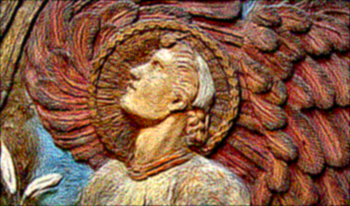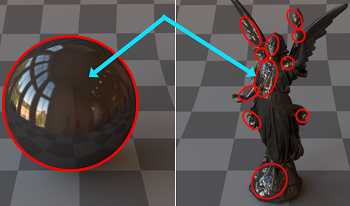
Structure-aware halftoning algorithms aim at improving their non-structure-aware version by preserving high-frequency details, structures, and tones and by employing additional information from the input image content. The recently proposed achromatic structure-aware Iterative Method Controlling the Dot Placement (IMCDP) halftoning algorithm uses the angle of the dominant line in each pixel’s neighborhood as supplementary information to align halftone structures with the dominant orientation in each region and results in sharper halftones, gives a more three-dimensional impression, and improves the structural similarity and tone preservation. However, this method is developed only for monochrome halftoning, the degree of sharpness enhancement is constant for the entire image, and the algorithm is prohibitively expensive for large images. In this paper, we present a faster and more flexible approach for representing the image structure using a Gabor-based orientation extraction technique which improves the computational performance of the structure-aware IMCDP by an order of magnitude while improving the visual qualities. In addition, we extended the method to color halftoning and studied the impact of orientation information in different color channels on improving sharpness enhancement, preserving structural similarity, and decreasing color reproduction error. Furthermore, we propose a dynamic sharpness enhancement approach, which adaptively varies the local sharpness of the halftone image based on different textures across the image. Our contributions in the present work enable the algorithm to adaptively work on large images with multiple regions and different textures.

Structure-aware halftoning algorithms aim at improving their non-structure-aware version by preserving high-frequency details, structures, and tones and by employing additional information from the input image content. The recently proposed achromatic structure-aware Iterative Method Controlling the Dot Placement (IMCDP) halftoning algorithm uses the angle of the dominant line in each pixel’s neighborhood as supplementary information to align halftone structures with the dominant orientation in each region and results in sharper halftones, gives a more three-dimensional impression, and improves the structural similarity and tone preservation. However, this method is developed only for monochrome halftoning, the degree of sharpness enhancement is constant for the entire image, and the algorithm is prohibitively expensive for large images. In this paper, we present a faster and more flexible approach for representing the image structure using a Gabor-based orientation extraction technique which improves the computational performance of the structure-aware IMCDP by an order of magnitude while improving the visual qualities. In addition, we extended the method to color halftoning and studied the impact of orientation information in different color channels on improving sharpness enhancement, preserving structural similarity, and decreasing color reproduction error. Furthermore, we propose a dynamic sharpness enhancement approach, which adaptively varies the local sharpness of the halftone image based on different textures across the image. Our contributions in the present work enable the algorithm to adaptively work on large images with multiple regions and different textures.

Gloss is an important appearance attribute, and its exact perceptual mechanisms are yet to be fully understood. Previous works attempted to model the relationship between optical and perceptual gloss. The state-of-the-art studies demonstrate that the human visual system has a poor ability to recover surface reflectance and perceived gloss rather depends on image cues that are generated by a complex interaction among optical material properties, illumination, object shape, and its surface geometry. Therefore, perceptual models defined on a particular shape, such as a sphere, may not generalize to other objects. To investigate shape-specific differences, we conducted a psychophysical experiment with a simple sphere and complex Lucy shapes. We scaled the magnitude of apparent gloss to study how the shape affects perceived gloss, and how the role of optical material properties varies between the shapes. We observed significant cross-shape differences, which we argue can be explained by the analysis of the image cues.